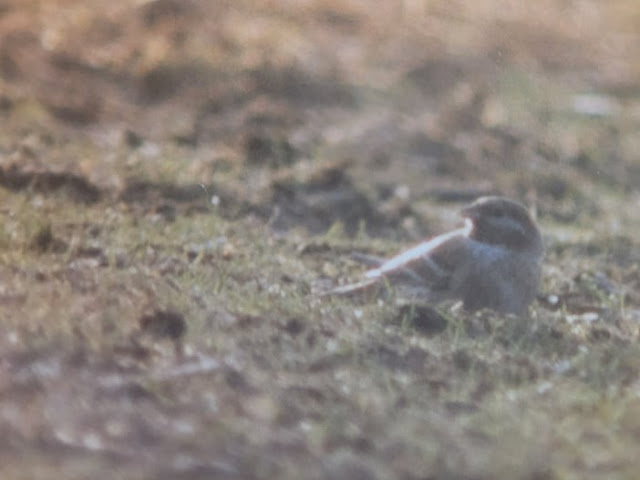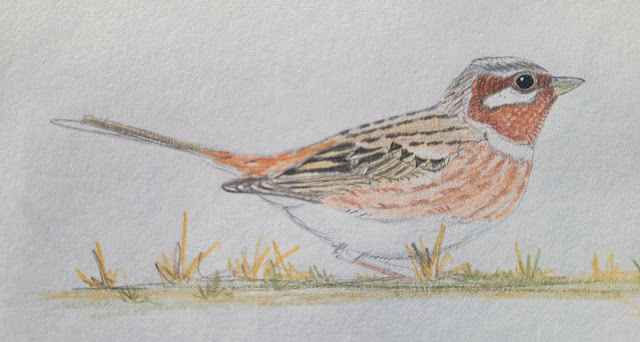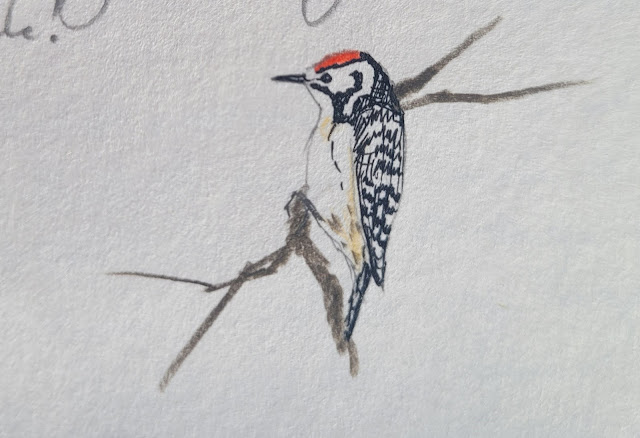2nd February:
After a scary, fog bound drive up overnight to Northumberland, we
arrived at Blakemore Farm, Cresswell nice and early and by 8am about 200
birders were on site. At about this time the local Yellowhammer flock started
to arrive and with them was our quarry – the male Pine Bunting. Over the next
90 minutes excellent views were had on the deck and I the hedge. [Eds: a
lengthy description followed in my journal].
 |
| Pine Bunting |
Alongside us on Cresswell Pond there were 45 Whooper Swans,
a lone Pink-foot and plenty of Teal, Wigeon, Coot and Little Grebes while a
Raven flew over. The sea was very active with birds nearly all of which were
Common Scoter but with a few Eider, Goldeneye and Mergansers. There were 20
Red-throated Divers and a single Black-throat.
The Bunting soon moved off so we headed south for the
Pennines. The weather was fine until we saw our first Red Grouse and then the
cloud descended and by the time we reached Langdon Beck we could barely see
anything at all. The Black Grouse were
heard displaying and we saw several grousey shapes shuffling around which was
very frustrating. The day was rounded up at Clumber Park in Notts where a
single Hawfinch was seen really well.
5th February:
A day out in the Brecks with Peter G started at East Harling
where an Arctic Redpoll had been reported with some Lessers and a Mealy for a
few days. We saw them all upon arrival
but they quickly departed leaving some of the birding illuminati to declare
Redpoll ID war on each other. A couple
of hours later we only had 25 Lesser Redpolls, 20 Tree Sparrows and ten
Brambling to show for our efforts as we scanned through the Chaffinches. A female Sparrowhawk soared over the pine belt.
[Eds: note that I tended to still mention every single Sparrowhawk back then].
We trundled down the road and had a coffee in a plantation
car park where two Crossbills were quickly found. The male was in fine song and
a Firecrest trilling away was a further bonus whilst Willow and Long-tailed
Tits milled around us.
Mayday Farm was very quiet with lots of Goldcrests and
singing Skylarks and 40 noisy Crossbills and the strangled ‘song’ of a Golden
Pheasant could be heard from the Moonberries before we moved on to Lackford for
lunch.
A huge mixed finch flock fed by the car park included 20
smart Brambling, 70 Lesser and two Mealy Redpolls and 120 vivid green and
yellow Siskins. A few Goldeneye and 12 Goosanders paddled around the lakes
before we called it a day and headed south.
 |
| Siskin |
A final stop at Hanningfield Reservoir did not produce the
adult Ring-billed Gull seen the previous evening by John Miller but we did see
a 2nd year Med Gull as recompense.
7th February:
Six Long-eared Owls were easily picked up at the Chase on a
short visit along with the Bullfinches.
8th February:
Pete and I tried again for the South Norwood CP Great Grey
Shrike and this time we found it within ten minutes. Really good views were had as it watched us
and sang cheerily to himself and he was so fluffed up that the wing coverts
were completely obscured. Seven Stock Doves, a Kingfisher, five Reed Buntings
and an obliging Kestrel were all seen before we moved on.
 |
| Great Grey Shrike |
I guided us across South London to Staines Reservoir where
the fog had once again reappeared. A quick peak from the top produced a
surprising raft of 77 Ruddy Duck while back near the car a winter male Black Redstart
was performing well. My second year tick of the day. Nearby at Wrasbury the Ring-necked
Parakeets were as good as ever and we found two pair of Smew and a few more
Goldeneye on Sunnymeads GP and Great Spotted Woodpeckers were vocal. A dashing
female Sparrowhawk interrupted lunch.
As it had brightened up we decided to head to Frensham Great
Pond where the Cetti’s Warbler eluded us but we were lucky with Dartford Warblers
with four pairs discovered. The males were in song and showed very well. To
round things up in a splendid fashion a hulking male Goshawk flew through and
with the temperature dropping we headed for home.
 |
| Dartford Warbler |
9th February
I took Paul Hawkins up to see the Waxwings in Harold Hill
which had returned to the same spot as last year by the A12. Three were seen
high up in their favourite Ash. The weather was closing in so we headed down to
East Tilbury into what soon became driving rain. The walk down was good though
and highlighted by 250 Black-tailed Godwits, 92 Avocet, two pair of Pintail, 40
Stock Dove and 26 Mute Swans. The Avocet
flock was my highest ever in Essex [Eds: sometimes well over 1000 down there of
a winter now] and quite a sight as they dozed on the river edge.
14th February:
[Eds: On the 13th February I hand delivered
nearly 400 Yellow Pages (remember pre-Google anyone?) around the local area and
ended up at my Grandparents in East Ham where I had a message from my Mum to
ring home. Ken Barrett had rung to let me know that there had been a male Pine
Bunting at Dagenham Chase all day… I spent the evening back home phoning round local
birders]
Well, by 7.40 the next morning Peter G and I joined rather crowd
of fifty and had seen the bird immediately.
It was almost identical to the Creswell bird except that the crown was
duller and more finely streaked, the mantle greyer and the face pattern even
clearer. It was feeding with 15 Yellowhammers at the side of the Curzon Pond where
I had the Purple Heron in 1990. A Greylag was a good site bird and six
Long-eared Owls showed to the masses.
On getting home I discovered that I had locked myself out…
 |
| Pine Bunting - Dave Cottridge |
15th February:
I helped the Chase Warden [Eds: Peter Massini I think] to
marshal the reserve today and there was a big Bunting crowd and the collection
bucket was doing very well. [Eds: I seem to recall Dom Mitchell hawking the
first issue of Birdwatch in the car park?] After this to took Stewart and
Aubrey up to see the Harold Hill Waxwings and four were seen although only a 1st
winter bird showed well. The Duckwood
Hawfinches showed well after a little wait and a male Lesser Spotted Woodpecker
performed nicely.
17th February:
Robin Chittenden invited me yesterday to join him at The
Chase in his portable hide to hopefully get some pictures of the Pine Bunting. We
got in and set up before first light but it was a bloody uncomfortable four
hours but I did get a couple of half decent shots. I counted 450 Lapwings and
six LEOs as I left.
 |
| Pine Bunting - by me |
18th February:
The Pine Bunting showed well again this morning and the
Lapwing flock had gone up to 650. Six LEOs took no notice of anything.
 |
| Long-eared Owl |
19th February:
A good look with
Peter G around Capel Fleet produced little with Marsh and Hen Harriers
quartering as usual and the wild Geese were still present. Seven Ruff were a
nice find as they fed with some cattle and Starlings. It was a lovely day and
so we went and spoiled it and spent the rest of the day seeing bugger all
around Snargate where once again there were no mega falcons.
21st February:
The Chase Pine Bunting is starting to look even better now
but pride of place went to the male Lesser Spotted Woodpecker seen in the same
bush! One of Ken’s friends – Alan Greensmith – was there and the Bunting was
his 6010th new bird!
 |
| Pine Bunting |
 |
| Lesser Spotted Woodpecker |
22nd February:
After the disappointment of not going to Devon [Eds: wonder
what that was for?] Peter G and I headed
south to Hampshire and its potential goodies. First stop after various
interesting diversions was Timsbury GP where Pete immediately found the drake Ring-necked
Duck paddling around with the Pochard. [Eds: I seem to remember viewing was
always tricky, up a bank and through a scraggly Hawthorn hedge alongside a busy
road and you could never see all of the pit or behind the island]. An adult
Yellow-legged Gull was also seen.
 |
| Ring-necked Duck |
The Titchfield Haven Little Bunting had not been seen and
the viewing conditions there were naf and so we trundled back up the valley to
where the adult Lesser White-fronted Goose had been reported. It was first seen
arriving two weeks previously with the local Brent geese and then spent the
next week loosely associating with 14 Russian White-fronts. As to its origins,
who knows but it was a smart adult bird and it was watched feeding warily by
itself in a sedgy field just a short way from the its Russian cousins. Birders
and dogwalkers were actually getting closer to the Russians!
 |
| Lesser White-fronted Goose |
Another quick look for the Titchfield Bunting proved useless
so we headed east towards Farlington with an unintentional detour via Lee-on-Solent
which bagged us a fluky adult Med Gull on the greensward.
Once at Farlington I left Pete in the car with his lunch and
braved the windy conditions to explore. As ever the Brent Geese were ridiculously
tame and I was pleased to get equally close to the Blackwits with 210 seen along
with a good spread of other waders. Pintail were roosting in the scrape but my
star find was a male Peregrine which obligingly sat amongst the Brents between unsuccessful
sorties.
 |
| Peregrine |
 |
| Black-tailed Godwits |
While watching him I was told of two Little Egrets at nearby
Thorney Island and so I scurried back to the car and told Pete. After he had
munched and slurped his way through an orange [Eds: a sight to behold…] we were
soon back on our way. However because of Pete’s crap map we made a total mess
of getting there and it took an hour to get to the right spot and sure enough
there was a Little Egret. Although fairly distant there was no questioning the
identity as it preened on a bank alongside a Grey Heron. Very little else was
seen in the biting wind bar a lone juvenile Shag and he was spending most of
his time under water!
Our final stop of ted at was nit far away at Climping beach in West Sussex where a single Shorelark was soon found amongst the sparse beach vegetation. A really good way to finish of the best day out so far this year.
 |
| Shorelark & Little Egret |
23rd February:
A Vaughan family day out to Suffolk which after a couple of
garden centres saw us at Belstead Brook on the south side of Ipswich where the
very elusive Black-bellied Dipper was luckily seen immediately as it dozed
under a little bridge over the road. It came out after about an hour and
perched up in the trees! What is amazing is that this is the same bird as the
1990-1991 bird at Burnham Market that means that it has completed at least
three North Sea crossings so far. Treecreepers, Grey Wagtails and various
finches were seen before we moved on.
 |
| Black-bellied Dipper - you can see the leg bling |
It was very quiet up at Butley although we did get a Barn
Owl and five Fallow Deer before heading to the Grandparents in Felixstowe where
the adult Iceland Gull was dutifully seen near the pier as usual.
24th February:
Another very frustrating day in North Kent chasing the Gyrish
falcon once again. It had spent the previous day delighting hundreds at Capel
Fleet but despite a very early start it was three and a half hours wasted with
every other raptor attempting to be our quarry with four ringtail Hen Harriers,
two Marsh Harriers and two Peregrines seen. One ringtail obscured itself in the
grass and had everyone fooled for 15 minutes. Rumours were circulating that
this bird is a hybrid being biscuit coloured while others say that the Snargate
bird was grey and white. Whichever way I look at it, it does not really matter
as I never even got close to seeing it! [Eds: I can’t remember what became of
the record but I can recall a grainy image of it chasing down a Mallard…]
The Russian White-front flock was up to 500 now.
25th February:
The Pine Bunting was still faithful to its favoured patch at the Chase although
I now had the bird to myself which was nice.
 |
| Pine Bunting - Dave Cottridge |
27th February:
A fine male Blackcap in the garden at home continued the ten
year run of this species overwintering.





No comments:
Post a Comment